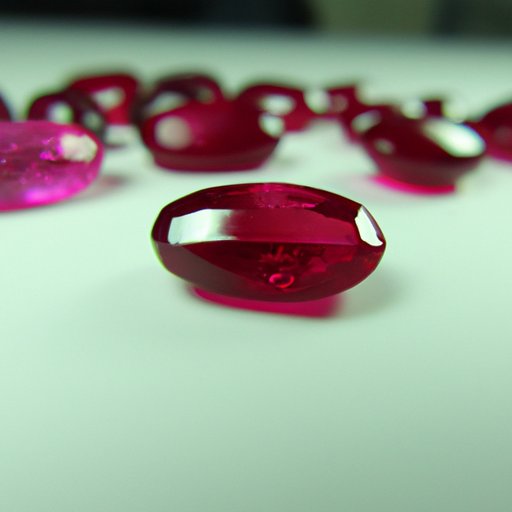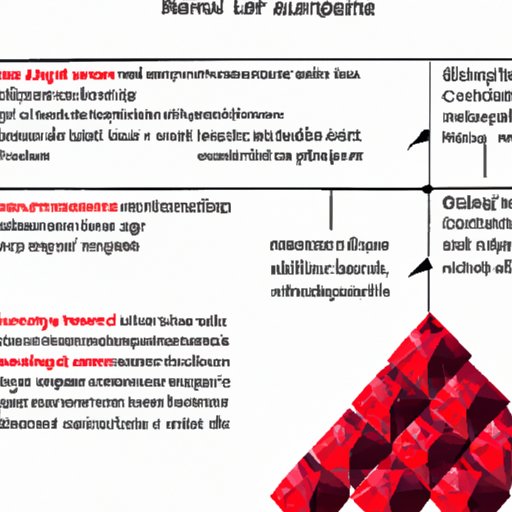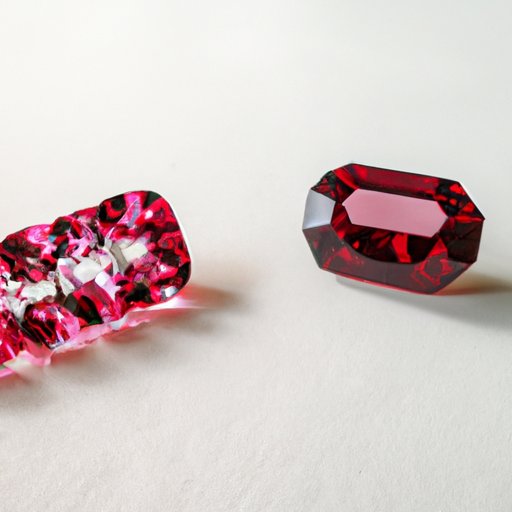Introduction
Rubies are one of the most sought-after gemstones in the world. From their captivating beauty to their rarity, they’ve been coveted by kings, queens, and jewelry lovers for centuries. But, how much does a ruby really cost?
In this article, we’ll explore the cost of rubies around the world. We’ll look at the factors that influence price, regional variations, and the differences between synthetic and natural rubies. By the end of this article, you’ll have a better understanding of ruby costs and how to find the best deal.
Cost Analysis of Ruby Jewelry
When it comes to ruby jewelry, there are many different types to choose from. Rings, necklaces, earrings, and bracelets are all popular options. The cost of these pieces can vary widely depending on several factors.
The first factor is the type of setting. Gold, silver, and platinum are among the most common metals used to create ruby jewelry. The metal used in the setting will affect the overall cost of the piece.
Next, consider the size and quality of the ruby itself. Rubies come in a variety of shapes and sizes, ranging from tiny chips to large faceted stones. The quality of the ruby is also important, as higher-quality stones will be more expensive. Clarity and color are two of the biggest factors that determine the value of a ruby.
Finally, think about the design of the jewelry. Intricate designs like filigree or engravings will add to the cost of the piece. On average, a simple ruby ring or necklace might cost anywhere from $100 to $1,000, depending on the quality of the ruby and the type of setting.
An Overview of Ruby Prices Around the World
Ruby prices can vary significantly around the world. In some regions, such as Southeast Asia, rubies may be less expensive due to the abundance of local supplies. In other areas, such as Europe, ruby prices may be higher due to the rarity of the gems.
The supply and demand of rubies also plays an important role in determining prices. If there is high demand and low supply, prices tend to rise. Conversely, if there is a surplus of rubies on the market, prices may be lower.
Investing in Rubies: What You Need to Know
Rubies can be a great investment, but there are some risks involved. As with any investment, it’s important to do your research before making a purchase. Look for reputable dealers who specialize in rubies and ask for certification papers to ensure the authenticity of the stone.
Be sure to inspect the ruby carefully before buying. Look for any flaws or inclusions that may affect the value of the stone. And, as with any purchase, be sure to compare prices to get the best deal.
Finally, it’s important to be aware of scams in the ruby market. Be wary of sellers who offer suspiciously low prices or push you to buy quickly without allowing time for inspection.

The Value of Rubies for Jewelry and Collectors
Rubies have long held a special place in the world of jewelry and collectibles. Their stunning red hue has captivated admirers for centuries, and their rarity makes them highly desirable. According to the Gemological Institute of America, “Rubies are among the most valuable colored gemstones, with only sapphires and emeralds being more valuable.”
In addition to their monetary value, rubies also carry a certain amount of historical significance. They have been used to adorn crowns, jewelry, and statues throughout history, and they have also been associated with luck and prosperity.

Factors That Influence the Cost of Rubies
When it comes to ruby prices, there are several factors to consider. Clarity and color are two of the most important factors, as they are directly related to the quality of the stone. The carat size of the ruby is also important, as larger stones tend to be more expensive.
Another factor to consider is the origin of the ruby. Stones from certain countries, such as Burma and Sri Lanka, are considered to be of higher quality and therefore command higher prices. Finally, whether or not the ruby has been treated can also affect the price.

Comparing Synthetic vs Natural Rubies: Price Differences
Synthetic rubies are man-made stones created to mimic the appearance of natural rubies. They are often used in jewelry and are typically less expensive than natural rubies. While synthetic rubies can be beautiful, they lack the rarity and historical significance of natural rubies.
On average, a synthetic ruby may cost anywhere from $20 to $200, depending on its size and quality. Natural rubies, on the other hand, can cost anywhere from $500 to $1,000 per carat, depending on the factors we discussed earlier.
Conclusion
Rubies are some of the most beautiful and sought-after gemstones in the world. From jewelry to collectors’ items, these stunning stones can be found in many forms and across a wide range of prices. Factors such as clarity, color, carat size, treatment, and origin can all affect the cost of a ruby.
When shopping for a ruby, it’s important to do your research and find a reputable dealer. Be sure to compare prices and inspect the stone carefully before making a purchase. With the right knowledge and a bit of patience, you can find the perfect ruby for your needs.
(Note: Is this article not meeting your expectations? Do you have knowledge or insights to share? Unlock new opportunities and expand your reach by joining our authors team. Click Registration to join us and share your expertise with our readers.)
